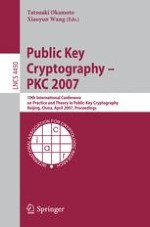2007 | Buch
Public Key Cryptography – PKC 2007
10th International Conference on Practice and Theory in Public-Key Cryptography Beijing, China, April 16-20, 2007. Proceedings
herausgegeben von: Tatsuaki Okamoto, Xiaoyun Wang
Verlag: Springer Berlin Heidelberg
Buchreihe : Lecture Notes in Computer Science
